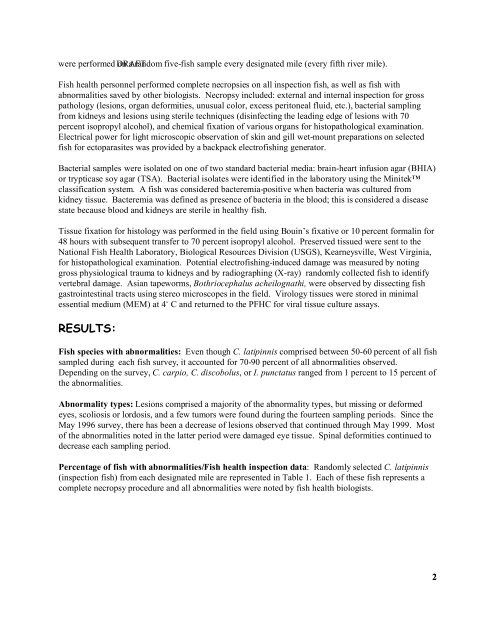Jerry Landye, Beth McCasland, Carol Hart, and Karl Hayden, Fish ...
Jerry Landye, Beth McCasland, Carol Hart, and Karl Hayden, Fish ...
Jerry Landye, Beth McCasland, Carol Hart, and Karl Hayden, Fish ...
Create successful ePaper yourself
Turn your PDF publications into a flip-book with our unique Google optimized e-Paper software.
were performed DRAFT on a r<strong>and</strong>om five-fish sample every designated mile (every fifth river mile).<br />
<strong>Fish</strong> health personnel performed complete necropsies on all inspection fish, as well as fish with<br />
abnormalities saved by other biologists. Necropsy included: external <strong>and</strong> internal inspection for gross<br />
pathology (lesions, organ deformities, unusual color, excess peritoneal fluid, etc.), bacterial sampling<br />
from kidneys <strong>and</strong> lesions using sterile techniques (disinfecting the leading edge of lesions with 70<br />
percent isopropyl alcohol), <strong>and</strong> chemical fixation of various organs for histopathological examination.<br />
Electrical power for light microscopic observation of skin <strong>and</strong> gill wet-mount preparations on selected<br />
fish for ectoparasites was provided by a backpack electrofishing generator.<br />
Bacterial samples were isolated on one of two st<strong>and</strong>ard bacterial media: brain-heart infusion agar (BHIA)<br />
or trypticase soy agar (TSA). Bacterial isolates were identified in the laboratory using the Minitek<br />
classification system. A fish was considered bacteremia-positive when bacteria was cultured from<br />
kidney tissue. Bacteremia was defined as presence of bacteria in the blood; this is considered a disease<br />
state because blood <strong>and</strong> kidneys are sterile in healthy fish.<br />
Tissue fixation for histology was performed in the field using Bouin’s fixative or 10 percent formalin for<br />
48 hours with subsequent transfer to 70 percent isopropyl alcohol. Preserved tissued were sent to the<br />
National <strong>Fish</strong> Health Laboratory, Biological Resources Division (USGS), Kearneysville, West Virginia,<br />
for histopathological examination. Potential electrofishing-induced damage was measured by noting<br />
gross physiological trauma to kidneys <strong>and</strong> by radiographing (X-ray) r<strong>and</strong>omly collected fish to identify<br />
vertebral damage. Asian tapeworms, Bothriocephalus acheilognathi, were observed by dissecting fish<br />
gastrointestinal tracts using stereo microscopes in the field. Virology tissues were stored in minimal<br />
essential medium (MEM) at 4 C <strong>and</strong> returned to the PFHC for viral tissue culture assays.<br />
RESULTS:<br />
<strong>Fish</strong> species with abnormalities: Even though C. latipinnis comprised between 50-60 percent of all fish<br />
sampled during each fish survey, it accounted for 70-90 percent of all abnormalities observed.<br />
Depending on the survey, C. carpio, C. discobolus, or I. punctatus ranged from 1 percent to 15 percent of<br />
the abnormalities.<br />
Abnormality types: Lesions comprised a majority of the abnormality types, but missing or deformed<br />
eyes, scoliosis or lordosis, <strong>and</strong> a few tumors were found during the fourteen sampling periods. Since the<br />
May 1996 survey, there has been a decrease of lesions observed that continued through May 1999. Most<br />
of the abnormalities noted in the latter period were damaged eye tissue. Spinal deformities continued to<br />
decrease each sampling period.<br />
Percentage of fish with abnormalities/<strong>Fish</strong> health inspection data: R<strong>and</strong>omly selected C. latipinnis<br />
(inspection fish) from each designated mile are represented in Table 1. Each of these fish represents a<br />
complete necropsy procedure <strong>and</strong> all abnormalities were noted by fish health biologists.<br />
2

















